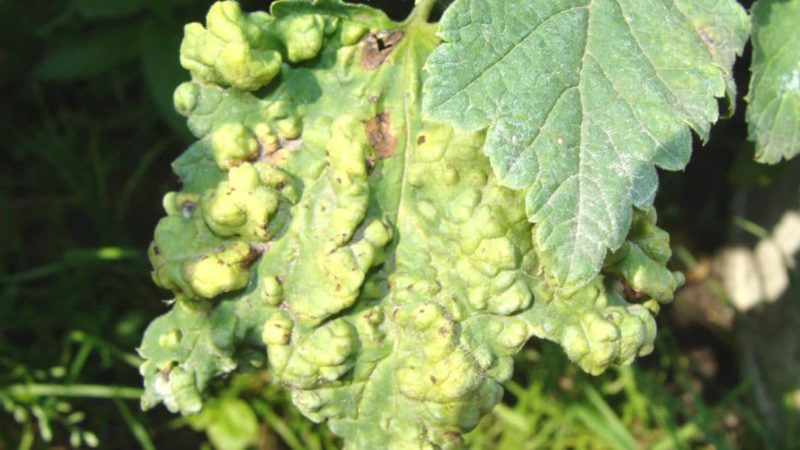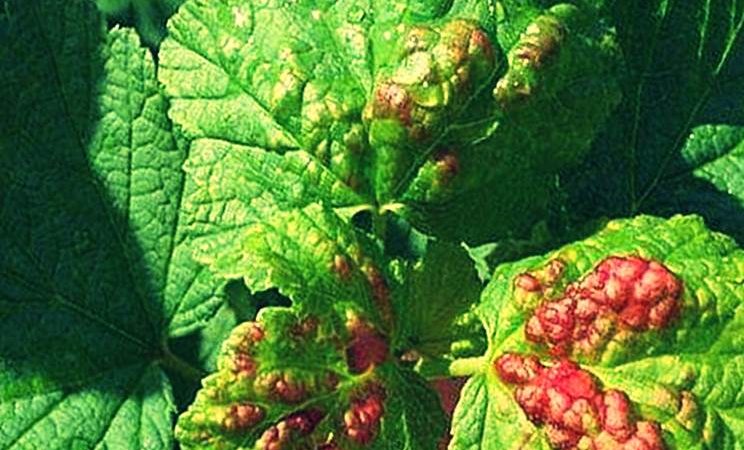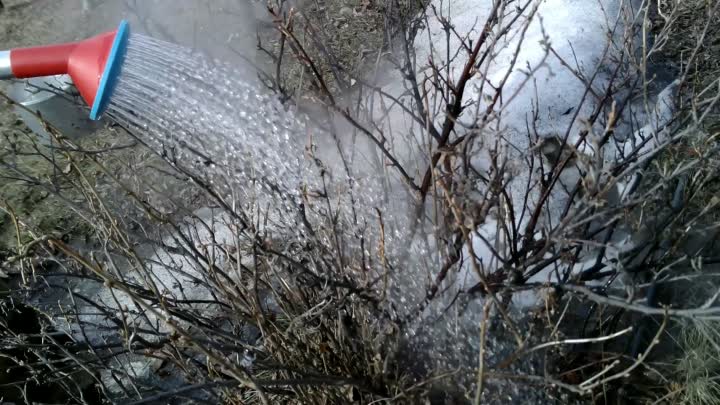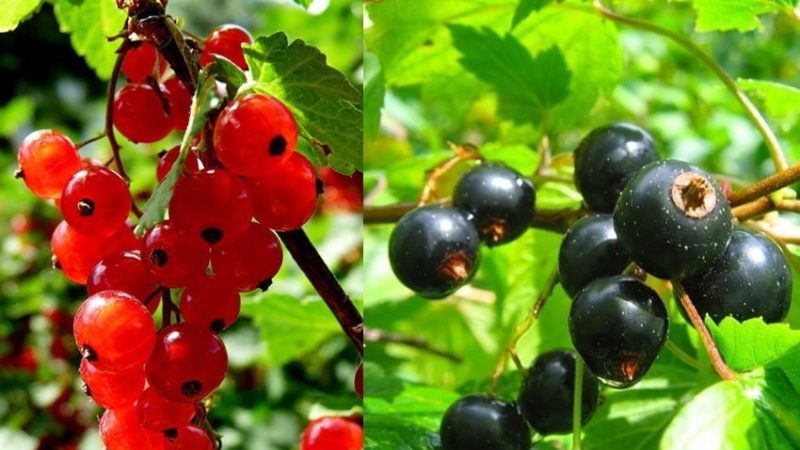What is currant anthracnose and how to deal with this disease
A competent gardener regularly inspects his property in order to notice the appearance of diseases or pests in time. The detection of dark or red spots on currant leaves, similar to ulcers, indicates an infection of the shrubs with anthracnose. To deal with the identified problem, you need to understand the nature of the disease and determine which methods of struggle will be most effective.
The content of the article
What is this disease
Anthracnose is a disease caused by the marsupial fungus Pseudopeziza ribis Kleb.
Its spores infect the foliage, stems and fruits of red and black currants, deprive the plant of access to nutrients, lead to oppression and death of the shrub.

What is dangerous for currants
If you ignore the first signs of anthracnose damage to currants, the spores begin to actively spread, affecting an ever larger area.
Plants lose their foliage. Red currants shed their leaves almost immediately, at the black plate they first curl up and then crumble. Spores clog the conducting vessels and prevent the bushes from eating well. Immunity decreases sharply, currants become vulnerable to other diseases and pests.
The volume of the harvest is reduced by 80-85%, the berries become smaller and lose their taste. Sometimes anthracnose recedes, but this does not mean that the disease will not come back again. Spores calmly overwinter on a bush or in the soil and the next year they attack the planting again, this time destroying the bush completely.
Spread
Infection occurs quickly under the influence of many factors.
Spores of the fungus are carried by:
- wind;
- rain;
- drops of water flowing down the leaves during watering;
- gardening tools, if you neglect their processing;
- insects.
Signs of infection

Anthracnose is detected when inspecting the bushes. Outward signs are often confused with the effects of acid rain.
The first symptoms are noted before the end of currant flowering. Tiny blonde at first yellow-green spots with glossy bumps in the center are formed on the lower leaves. They gradually increase until they cover the entire surface of the leaf plate. The color of the spots becomes brighter, and a dark border appears around.
It is at this stage that gardeners take stains for the effects of acid rain, however, such burns do not have a dark border. Sick leaves stop the production of chlorophyll, which is why they wither and crumble ahead of time. At this time, the spores rise higher, affecting the rest of the plant.
Reference. Because of the color of the spots, anthracnose is also called copperhead.
The next stage is the formation of gray-brown wounds in the area of petioles and young shoots. This leads to the fact that the mass of the plant decreases, it "becomes bald", new branches develop more slowly and do not have time to get stronger by winter. The currant suffers already at the first frost.
With a strong lesion, black growths form on the stalks and berry clusters, the fruits do not receive nutrients, which is why they lose their taste and appearance, become smaller and dry... The flourishing of the disease occurs in July and August, by which time the shrubs are bare.
The reasons for the development of the disease
The infection appears in May or late August, early September.
The following factors can provoke diseases:
- hot weather combined with high humidity (anthracnose is not dangerous in a drought);
- improper sanitary pruning of the stems, leading to serious damage to the shoots.
The risk of infection increases when pests attack. Insects spread the fungus on the legs and wings.
The most vulnerable are plants, the immunity of which is weakened by outbreaks of diseases or lack of fertilizers.
Treatment methods
For the treatment of anthracnose, biological products, folk methods, fungicides and simple agricultural techniques are used.
The choice of method depends on the intensity of the lesion and the time when treatment is required. The best effect is obtained by combining several methods at once.

Chemicals
Fungicides give quick results and fight anthracnose more effectively, but they should be used only according to the instructions on the package and at a certain time.
In early spring they use:
- copper sulfate;
- DNOC;
- "Nitrafen".
Before the appearance and disclosure of buds, apply:
- "Cumulus";
- "Tiovit Jet".
After flowering, preparations such as Captan and Tsineb are suitable. They also carry out processing after harvesting.
Important! When processing, make sure that both sides of the leaves are wet.
Biological preparations
Biologics are non-toxic, safe for plants and humans, therefore they are used in conjunction with traditional methods during the ripening period of berries.
Gardeners especially appreciate:
- Fitosporin;
- "Gamair".
These funds stop the development and reproduction of the fungus, preventing the appearance of the next generation.
Agrotechnical techniques

There are several secrets to stop the spread of fungus... In early spring, before the buds swell, the bushes and soil are poured over with hot water (+ 65 ... + 70 ° C). At the first sign of illness, the affected leaves and shoots are cut and burned outside the garden to avoid infecting other plants.
Strong thickening of the bushes should not be allowed, preventive pruning is necessary.
After each watering or rainfall, the soil is loosened and weeds are removed. Do not leave fallen leaves, branches and other plant debris under the bushes.
Traditional methods
At the first signs of anthracnose, when spots are visible only on the lower leaves, folk solutions and infusions are used.
How to treat a plant:
- 300 g of garlic cloves in the husk pour 10 liters of boiling water and leave for 24-48 hours, after which spray the whole bush.
- Half a piece of laundry soap is diluted in 10 liters of water and sprayed on all plantings.
- The soil, the base of the bush and shoots are treated with iodine solution (1 drop per 1 liter of water).
Processing is carried out 1-2 times a week until the signs of infection disappear completely.
Features of the struggle during flowering, fruiting, dormancy
Do not treat currants with fungicides during the formation and ripening of berries. Toxic substances do not have time to undergo decay and can harm your health.
They are not used during flowering either: this will scare off pollinating insects, which will significantly reduce the volume of the crop. The rest of the time, chemistry is the most effective way to combat anthracnose.
Preventive measures

The appearance of anthracnose will help prevent preventive measures:
- in autumn and spring, they carry out sanitary pruning, removing dry and damaged shoots (while the tools are treated with a weak solution of potassium permanganate, and the cuts are sprinkled with wood ash);
- use microfertilizers "Fertika Autumn" and "Fertika Vesna";
- water the currants at the root, avoiding the sprinkling method;
- process buds and bushes after picking berries Bordeaux liquid (3%), suspension "Phtalan" (0.5%), "Kuprozan" (0.4%);
- use complex fertilizers that increase the immunity of currants.
Fertilizers are selected depending on the time of use.
Below are the recipes for the most popular (for 10 liters of water):
- 1 tbsp. l. potassium sulfate and ammonium nitrate, 1/2 tsp. boric acid and 3 g of ferrous sulfate - in early spring before the beginning of the growing season.
- 200 g of ash, 1 package of sodium humate, 2 tbsp. l. potassium sulfate, 1 tbsp. l. superphosphate - during the formation of ovaries.
- 1 tablet of a biostimulating agent "Immunocytofit", 2 tbsp. l. potassium sulfate, 1 tbsp. l. superphosphate - during flowering, then repeat after flowering and a third time - after 30 days.
Complex fertilizers help the currants get a large amount of nutrients, strengthen the immune system, increase resistance to insect attacks, allow you to quickly build up green mass and speed up the ripening of berries.
Conclusion
Anthracnose is dangerous for currants, therefore it is necessary to react to its appearance immediately so that the disease does not spread throughout the garden.
Do not neglect preventive measures: well-groomed plantings get sick less often and are distinguished by strong immunity. If the disease is not overcome immediately, the fungus will appear the next year, depriving hope for a good harvest and destroying most of the plants.